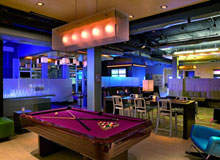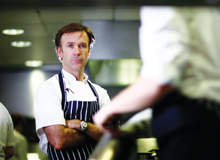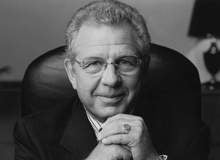
Frits van Paasschen likes to run. More than a year after he became CEO of Starwood Hotels & Resorts Worldwide, he still does a ten-mile run at 6am each day.
He says it helps his management technique. The new CEO has run 12 marathons, and at the NYU Hospitality Investment Conference in June 2008, Starwood held a 5.1-mile “Run with Frits” bonding event for developers, through New York’s Central Park. He had to slow down so the others could keep up.
Van Paasschen, 47, took the reins of Starwood in September 2007 after its board ousted then-CEO Steve Heyer that March amid allegations about his personal conduct and management style. After a five-month search the board found its man in the former Coors Brewing CEO, choosing him unanimously.
“Head and shoulders above the rest” was how chairman and interim CEO Bruce Duncan described van Paasschen, adding that the Dutch-born executive stood out because of his “intellectual firepower”. Van Paasschen has more than 20 years of experience with consumer-focused global lifestyle brands and made his name by successfully realising global strategies for megabrands Disney, Nike and Coors.
At van Paasschen’s previous post at Coors he reversed years of decline and substantially increased sales and profits, while growing market share and raising brand stature. Expectations at Starwood HQ in White Plains, upstate New York, are understandably high.
He took over Starwood at a time when the company had a robust pipeline of 105,000 rooms. Any hushed talk of possible economic trouble ahead was dismissed as idle chatter – even paranoia.
How well do you really know your competitors?
Access the most comprehensive Company Profiles on the market, powered by GlobalData. Save hours of research. Gain competitive edge.

Thank you!
Your download email will arrive shortly
Not ready to buy yet? Download a free sample
We are confident about the unique quality of our Company Profiles. However, we want you to make the most beneficial decision for your business, so we offer a free sample that you can download by submitting the below form
By GlobalDataIt was 2007 and the global hospitality industry was having one of its best years on record. Fast forward a year and the US economy is in freefall.
Despite its renowned resilience, the hotel industry is suffering.
Van Paasschen has a big task ahead in an unprecedented economic environment. “I wanted a challenge and an adventure, and the year has provided that,” he says, describing what he calls the “extraordinary” design, branding and financial opportunities available.
Van Paasschen is confident that he can accelerate Starwood’s transformation into a major international company, he tells me from his office at Starwood HQ. Arriving in the US from the Netherlands as a child, he maintains a deeply rooted international outlook, which makes him a natural in the industry.
He already speaks five languages and is currently learning Czech with his chauffeur.
Because he lacked hotel experience, van Paasschen immersed himself in the industry.
He has visited 190 hotels in 20 countries and 45 cities. “The pivotal point for us is the general managers, on whom success or failure fall,” he tells me.
“I meet them and make sure I know what’s going on.” In contrast to the stuffiness of some CEOs, van Paasschen is informal and friendly.
He rarely wears a tie.
His appointment raised eyebrows but Starwood is known for doing things differently. Its W brand made waves in the industry with its cool style ethos, which included the much-imitated concept of the living-room lobby, where guests can relax with friends, a laptop or cocktails.
Starwood operates 900 hotels in 100 countries across nine brands. Luxury and upper-scale properties make up 70% of the portfolio.
These include The Luxury Collection, St Regis and W Hotels, plus upper-upscale brands Sheraton, Le Méridien and Westin. Upscale brands are Four Points by Sheraton and the new brands aloft and Element.
Van Paasschen likes the balance of the portfolio. He singles out Le Méridien as a big success in bringing an outside brand successfully into the Starwood stable.
He emphasises the importance of global expansion and building brands such as Sheraton, Westin and St Regis.
Van Paasschen plans to continue Starwood’s strategy of transforming from a US-based company into an international powerhouse. He’s determined to set the pace for hotel development as rivals such as Marriott, Hilton and Hyatt also sprint into emerging cities.
Starwood is opening an extraordinary 600 hotels in the next four years, half of which will be in new markets such as China and India. “We want to take advantage of the rise of the middle class and the expansion of tourism to and from other parts of the world,” he explains.
The journey through economic crisis
Despite the economic slowdown, Starwood reported a profit of $129m or 0.71 cents a share for the third quarter. Starwood has not radically adapted its strategy, what van Paasschen calls the “Starwood journey”, in the economic downturn.
The essentials are “Starwood-class brands, great execution, global growth, brilliant talent and market-leading returns”.
“Our future openings for next year and 2010 are financed and under construction, and only under dire circumstances would they be cancelled,” he says. “I might have said three months ago that we were still robustly financed, but now we have to look at this on a day-to-day basis. We have about 100 openings planned for 2009,” he continues.
“Although we’ve been focused on growing, we’d rather fall short in growth than compromise on working with the best partners on the best properties for the most appropriate brands. The luxury of having a strong pipeline is that we can walk away if we don’t get what we feel is appropriate.
“Fundamentally we haven’t changed because if you have a brand that customers want to stay with, that remains the case even in this global climate,” he explains. However he adds that it would be foolish to think that no segment of the industry will be affected.
“Companies that can meet customer needs wherever they go in the world and work on the biggest scale are in a better position. Smaller, one-off operations could be in for a harder time,” he says.
As for Starwood, van Paasschen says that it intends to streamline its operations without losing opportunities. “Our strategy is the same but we are focusing more on managing expenses,” he says.
He sees opportunity in the recession, quoting President-elect Barack Obama’s chief of staff Rahm Emanuel’s maxim: “You never want a serious crisis to go to waste.” “These crises offer opportunities for the CEO of a business to ask difficult questions about how the company operates internally,” says van Paasschen.
“Only time will tell if there are opportunities for investment. We have the experience of Le Méridien, which we brought into Starwood three years ago. With the challenges in 2009, who knows?”
Van Paasschen’s background
Van Paasschen grew up in Seattle and was educated at Amherst College in Massachusetts. After reading an article in Harper’s magazine about the glamorous lives of young consultants, he decided to work for the Boston Consulting Group.
He later returned to school, earning his MBA at Harvard Business School, followed by work at McKinsey Consulting in Los Angeles.
In 1995, van Paasschen joined Disney’s consumer products division to gain more global experience. He established Disney’s first retail stores in Japan and crafted a strategy to open new markets in countries including Poland.
Nike recruited him in 1997 to spearhead strategic planning for the $3bn-a-year company, soon to become a $9bn-a-year company. Van Paasschen was successful at Nike, introducing Brazil and Russia to the company’s products.
He left as one of four division chiefs in charge of Europe, the Middle East and Africa operations and having increased revenue from $2.5bn to $4bn. Profits doubled in a four-year period.
After seven years at Nike, van Paasschen became CEO of Denver-based Coors Brewing, Molson Coors’ largest division. During his two years there, he reversed nine quarters of declines in sales of Coors Light beer, partly by adding a temperature-sensitive label that turns blue when the bottle is chilled.
He also added regional general managers who focused on profit instead of volume.
Team sport
Starwood undoubtedly wants van Paasschen’s profit-boosting ability to rub off at White Plains. His first year has not been without controversy.
He recently brought Tom Clarke, Nike’s then-president, to Starwood, and hired Phil McAveety, a former Nike global marketing executive, as Starwood’s chief brand officer in a contentious move. He has big plans for Starwood, wanting to push brand recognition to greater heights.
When he hired McAveety, the move added a new management layer above Ross Klein, Starwood’s luxury brand president who oversaw the W chain’s successful expansion for five years. Klein quit Starwood and signed on with rival Hilton.
Van Paasschen also promoted Matthew Avril, formerly co-president of Starwood Vacation Ownership, to president of the hotel group. “Senior management is a team sport,” explains van Paasschen.
“The best strategy is to combine people who have distinct viewpoints and backgrounds, and it’s the coming together of that group with a shared objective that makes it work. We have a great balance of people from the industry, from the outside and promoted from within the company.”
Van Paasschen is focusing on building a new team, improving employee morale (“spending more time together in this economic climate is great for team spirit”) and selling the idea of hotels. He tells me that despite the downturn and downsizing, guest satisfaction scores have gone up, citing Starwood’s Service Culture Training Programme as the reason.
For van Paasschen, echoing his big-brand business roots, success at hotel level is about delivering a thorough but individual brand experience. “We will deliver a service so that people feel they’re being handled individually as they would when staying at any great hotel,” says van Paasschen, adding that Strarwood delivers what its customers demand.
“The W brand started as a four-star hotel and evolved into a five-star because it was pulled that way by customers to fill a gap. Coming from Nike, I know that you can lose exclusivity when you have more distribution points, but you can also create it by keeping the quality high.”
Van Paasschen does not see luxury as a commodity that needs to be restricted. He believes the opposite; that it should be allowed to flourish.
“Why can’t you have five Ws in London or five in Mumbai?” he asks. “Most luxury chains when they reach 75 or 100 hotels might find it difficult to locate new places to open. I don’t see W like that.”
For the Starwood CEO, luxury and tradition don’t have to go hand in hand. “Luxury can go together with modernity as well,” he says.
“It’s about delighting people between Regis, W and the Luxury Collection so that we can tailor what luxury means for different types of guest.”
The millennial guest
“Brands increasingly have to be about a relationship and an emotional connection that you bring to people,” says van Paasschen, adding that this makes business challenging for Starwood but plays to the company’s strengths.
Despite the weakness of the US economy and the possibility of a prolonged recession, van Paasschen remains optimistic. “We’ve been students of previous recessions,” he says.
“The onset of a recession usually precedes lower RevPAR performance, so this time the consumer probably put the brakes on in December 2007 but we didn’t see the effects until May or June 2008.
“RevPAR troughs are when we can start guessing at the recovery, which might come quicker than expected. It would be great if 2008 were the bottom, but I’m not sure if that’s true as the recession on liquidity has yet to work through the economy and consumer and business behaviour. I think the first and second quarters of 2009 will be difficult but we will see a change by the end of 2009. That is my best guess.”
Van Paasschen says that Starwood is in a better position than others because it draws more business travellers as opposed to leisure travellers, who are more likely to curtail their spending. He says that he is getting positive feedback from his army of Starwood GMs on the ground.
“I don’t think people are worried,” he reveals. “We have a leadership group that saw the downturn after 9/11, post-SARS and following the Asian and Latin American financial crises of the late ’90s. They take the long view so we are keeping our nerve and taking appropriate measures, but not hitting the panic button.”
What’s next?
Mid-range markets are in Starwood’s sights, with a new brand, aloft, designed with W’s style and opening 500 hotels in the next five years. The company is also launching Element, an extended-stay chain designed as a lower-priced alternative to Westin.
Both incorporate eco-friendly design and operation. “I think it will be increasingly good for business to be green,” he says.
Element debuted in Lexington, Massachussets in April 2008. Starwood has established the first big hotel chain that requires all of its properties to receive Leadership in Energy and Environmental Design (LEED) certification from the US Green Building Council, a nationally accepted benchmark for the design, construction, and operation of high-performance green buildings.
The 124-room, extended-stay hotel serves as an eco-laboratory where Starwood will test green construction, products and operations from low-volatile organic compounds, water-efficient taps and carpets woven with 25% recycled material, before rolling these features out to the 20 other Element hotels scheduled to open in the US by the end of 2009.
“With Element we can learn what we can do to be different,” he says. “Where that journey takes us is difficult to predict, apart from the standard going up. Market research says the willingness to pay for green credentials is inversely proportional to age, so there will be an increasing affluent market for green hotels.”
Van Paasschen says that new brand launches are not a priority at the moment. “We feel the nine we have are great flying in formation,” he says.
“We don’t see any obvious holes. But if the right thing comes along, as with Le Méridien, then we can find space for it.”
His immediate job is to ensure that Starwood achieves the goal of having the best portfolio possible, with 1,500-2,000 hotels around the world that offer great experiences for guests. “Growing up I was always fascinated by the great European explorers, such as Columbus and Magellan,” he says.
“I admired their curiosity.” The Starwood CEO even owns a collection of old maps that show the world as they saw it.
“I’ve been accused of being an optimist. I have great confidence when I look across our portfolio of opportunities,” says van Paasschen, Starwood CEO and marathon man.
Now all Starwood has to do is keep up.







